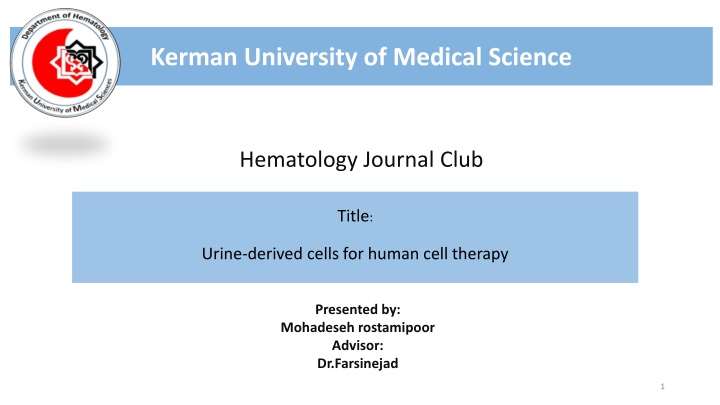
Stem Cell Therapy Options for Human Cell Regeneration
Explore the potential of urine-derived cells for cell therapy in regenerating diseased or injured tissues. Discover the classification, differentiation potentials, and origins of stem cells, including mesenchymal stem cells and embryonic stem cells. Learn about the advantages and disadvantages of various stem cell sources such as cord blood, fetal, and induced pluripotent stem cells.
Download Presentation

Please find below an Image/Link to download the presentation.
The content on the website is provided AS IS for your information and personal use only. It may not be sold, licensed, or shared on other websites without obtaining consent from the author. If you encounter any issues during the download, it is possible that the publisher has removed the file from their server.
You are allowed to download the files provided on this website for personal or commercial use, subject to the condition that they are used lawfully. All files are the property of their respective owners.
The content on the website is provided AS IS for your information and personal use only. It may not be sold, licensed, or shared on other websites without obtaining consent from the author.
E N D
Presentation Transcript
Kerman University of Medical Science Hematology Journal Club Title: Urine-derived cells for human cell therapy Presented by: Mohadeseh rostamipoor Advisor: Dr.Farsinejad 1
Cell therapy Cell therapy aims Restore diseased or injured tissues Replacing lost cells with functional cells Re-establish normal function Stem cell & somatic cell 2
Stem cell Stem cells can differentiate into various tissue specific lineages 3
Stem cell Classification of stem cells Source of origin Differentiation potentials 4
Stem cell Differentiation potentials Totipotent Pluripotent Multipotent Unipotent 5
Stem cell Mesenchymal stem cell (MSC) Multipotent Differentiation to mesoderm, endoderm, ectoderm MSCs derived from different tissue including : Bone marrow Adipose tissue Amniotic Testis Liver Lung Dental pulp Umbilical cord blood Menstrual Blood Stem Cells 7
Stem cell Source of origin Cord blood SC Fetal stem sell ips Embryonic Adult stem cell 8
Stem cell Embryonic stem sell Inner cell mass of blastocysts Advantages: Totipotent Pluripotent Have the ability to produce all type Disadvantages: Teratoma Ethical issues 9
Stem cell Fetal stem cell Amniotic Advantages: Multipotent No teratoma Disadvantages: Autologus 10
Stem cell Cord blood stem cell Advantages: Mesenchymal stem cell (MSC) Haematopoietic stem cells (HSC) Multipotent Low immune response Disadvantages: Autologus 11
Stem cell Induced pluripotent stem cell (ips) Advantages: Pluripotent Reprogramming and differentiation KLF4 C-MYC OCT4 SOX2 Disadvantages: Oncogenes 12
Stem cell Adult stem cell Bone marrow Adipose tissue Amniotic Testis Liver Lung Dental pulp Umbilical cord blood Menstrual Blood Stem Cells 13
Stem cell Adipose derived Stem Cells Advantages: MSC Differentiate to Bone Cartilage Fat Muscle Disadvantages: liposuction or invasive methods for isolation 14
Stem cell Dental pulp Advantages: MSC High division Differentiate Autologus 15
Stem cell Menstrual Blood Stem Cells Advantages: Multipotent Express MSC & ESC markers 16
Stem cell Urine-derived stem cells Ease of isolation No invasive and painful procedures Cost of biopsy Suitable for auto-transplantation Not induce immune responses or rejection 17
Stem cell Urine-derived stem cells Isolation of urine-derived cells Seeding them onto culture plates Antibacterial wash Centrifugation 18
Stem cell Urine-derived stem cells MSC Progenitor cells that can be converted into cells of multiple lineages Expression kidney cortex markers Originate from the kidney 19
Stem cell Urine-derived stem cells USC have high expandability Doubling time of 21 24 h Secrete angiogenic paracrine growth factors Vascular endothelial growth factor (VEGF) Fibroblast growth factor (FGF) Insulin growth factor (IGF) Hepatocyte growth factor (HGF) Platelet-derived growth factor (PDGF) 20
Stem cell Urine-derived stem cells Therapeutic applications Lack of robust donor-derived cells Non-invasively Differentiated into multiple lineage Autologous transplant 21
Stem cell Urine-derived stem cells Therapeutic applications Ease of donor sample collection Minimal ethical issues Low costs Simple method of cell isolation No immune rejection Widespread clinical applications 22
Stem cell Urine-derived stem cells Therapeutic applications Autologous cell therapy Kidney bioengineering Cardiac repair Liver reconstruction Diabetes treatment Bone engineering Muscle engineering 23
Stem cell Urine-derived stem cells Kidney bioengineering Smooth muscle Myocytes Epithelial cell Endothelial cells Reduce inflammation, oxidative stress, and tubular injury Differentiated in to: Bioartificial kidneys 24
Stem cell Urine-derived stem cells Genitourinary repair Treat end-stage bladder diseases or bladder pain syndrome Treat stress urinary incontinence (SUI) 25
Stem cell Urine-derived stem cells Cardiac repair Pluripotent cells are hard to obtain Differentiated myocytes from urine cells expression Myofibrillar proteins Myogenic differentiation (MyoD) Myogenic factor 5 (Myf5) 26
Stem cell Urine-derived stem cells Liver reconstruction In acute liver failure transplantation Donor tissue insufficiency Immunogenicity Patient-specific hepatocytes 27
Stem cell Urine-derived stem cells Diabetes treatment Requires a large number of cells Using urine cells these numbers are achievable Require life-long immune suppression Urine cells can bring revolutionary changes in diabetes treatment 28
Stem cell Urine-derived stem cells Bone engineering Large number of cell ESC- and iPSC and Adipose derived stem cells are generally used Non-invasively 29
Stem cell Urine-derived stem cells Muscle engineering Differentiated muscle cells from urine cells can be more effective May require more than one transplant using autologous self-renewing functional cells 30
Stem cell Urine-derived stem cells The growth of urine cells is age-dependent source of cells for therapy USC have better immune tolerance USC have better expandability ideal choice for generating a donor cell bank 31
Thank you 32
